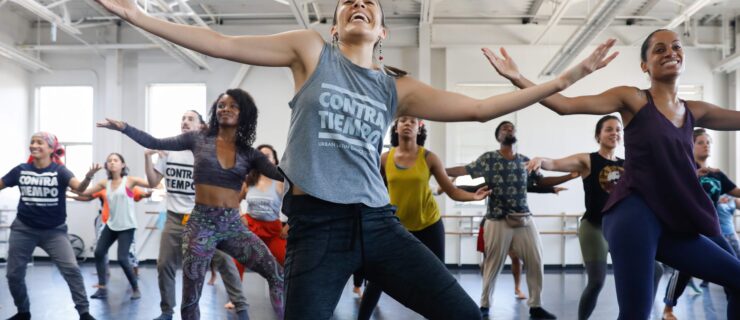Clogging: How it's different from tap
When you think of clogging, do you envision swirly skirts, petticoats and shiny white shoes? And do you hear fiddles, banjos and some straight-time clacking of taps?
Time to leave the past behind! Although some people still enjoy traditional clogging, today’s cloggers are just as likely to dance to hip-hop beats. In fact, modern clogging looks suspiciously similar to tap dancing. Both involve metal-tipped shoes, fast-paced music and a lot of stomping. But how alike are they really?
Close and Getting Closer?
Tapping and clogging are both based on European folk dances that were brought to the U.S. in the 1700s and 1800s by settlers from England, Ireland and Scotland. But once here, the two dances evolved in different ways.
Tap is an urban artform. It developed mainly in NYC in the mid-1800s when dancers blended African rhythms and steps with elements used in percussive Irish and British dances. It became popular on the show-business circuit, and new ideas traveled quickly as dancers went on tour.
Clogging, on the other hand, began as a rural artform based in the Appalachian Mountains region. It developed slowly, since fewer people traveled. Dancers were introduced to new ideas less frequently, so clogging stayed close to its historical roots until recently.
Ira Bernstein, an expert in percussive dance ranging from Appalachian flatfooting (a type of clogging) to rhythm tap, says clogging changed radically in the late 1980s when Gregory Hines brought tap into the mainstream.
“Percussive dancers looked to Gregory as their role model. You began to see cloggers stealing his steps—throwing pullbacks and wings into competition routines,” he says.
Susan Phillips, the co–executive director of CLOG, Inc., the national clogging organization, also sees strong modernizing trends in the genre.
“Now, only teams competing in the southern Appalachian style wear traditional costumes,” she says. The music has also changed, embracing rap, hip-hop and pop of the 21st century.
Steps and Music
Despite an increasing similarity between the two styles, clogging is distinctive. Cloggers wear different shoes than tappers, using a split, or articulated, tap. Some cloggers also use a “buck tap,” a metal piece that comes over the front of the toe for a metallic sound during toe tips.
Buck dancing is one of clogging’s recent innovations and suggests a closing of the gap between tapping and clogging. Traditionally, cloggers remain flat-footed when dancing. However, buck dancers—like many tappers—keep their weight on the balls of the foot and alternate heel and toe movements to make a pattering sound. The distinction is important on the clogging competition circuit, since judges separate dance styles into different categories so that those who incorporate flashy, modern steps aren’t given an unfair advantage.
The physical limitations involved in making sounds from metal-tipped shoes mean that many of the steps used in both styles are similar. Tappers and cloggers both know what a stamp, stomp and tip is. Other steps are similar in execution, even if they are given different names: A clogging “double toe” is like a tap “shuffle.”
There are artistic differences, though. “Tap dance is much more intricate,” says Bernstein. However, some clogging conventions are difficult for tappers. Cloggers typically use the heel on the downbeat of the music and the toe on the upbeat. While Bernstein says this is not a hard-and-fast rule, it does give clogging its unique sound and can prove tricky to those trained in tap.
Tappers used to rhythmic flexibility and jazz syncopations might find the straight-time clogging approach restricting. In some ways, that’s one of the main differences between the two: Tappers often dance based on a “swung” rhythm like a jazz triplet, while cloggers’ dance to a straight rhythm, like a march in a two-count.
Why Pick One Over The Other?
So how does a dancer choose? Phillips says sometimes it simply depends on which studio and teacher are closer! Or, “Some students choose to pursue clogging because there are more performance opportunities,” she adds. But there’s no reason not to explore both. Though Bernstein agrees it can be a bit confusing at first to “translate” your thinking from one style to another, it doesn’t take long to get over. So why not try tapping and clogging?



